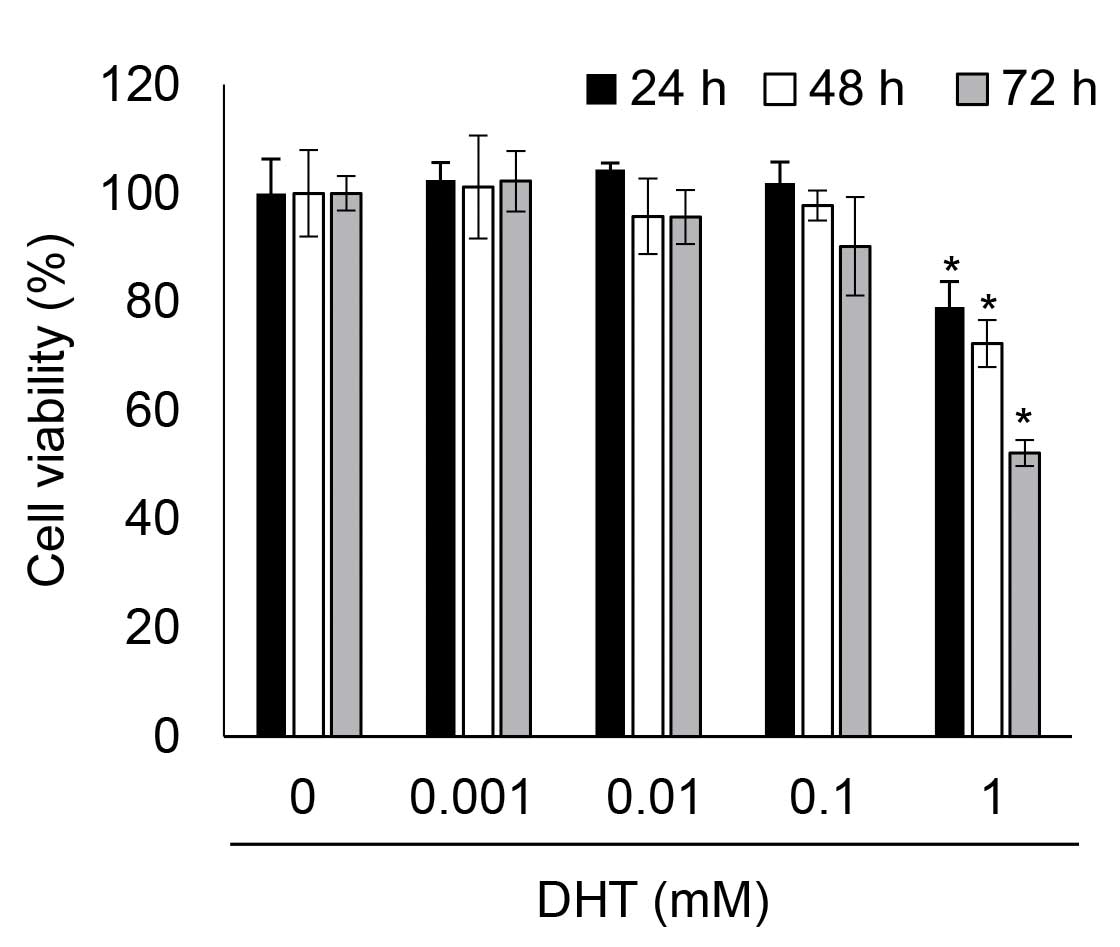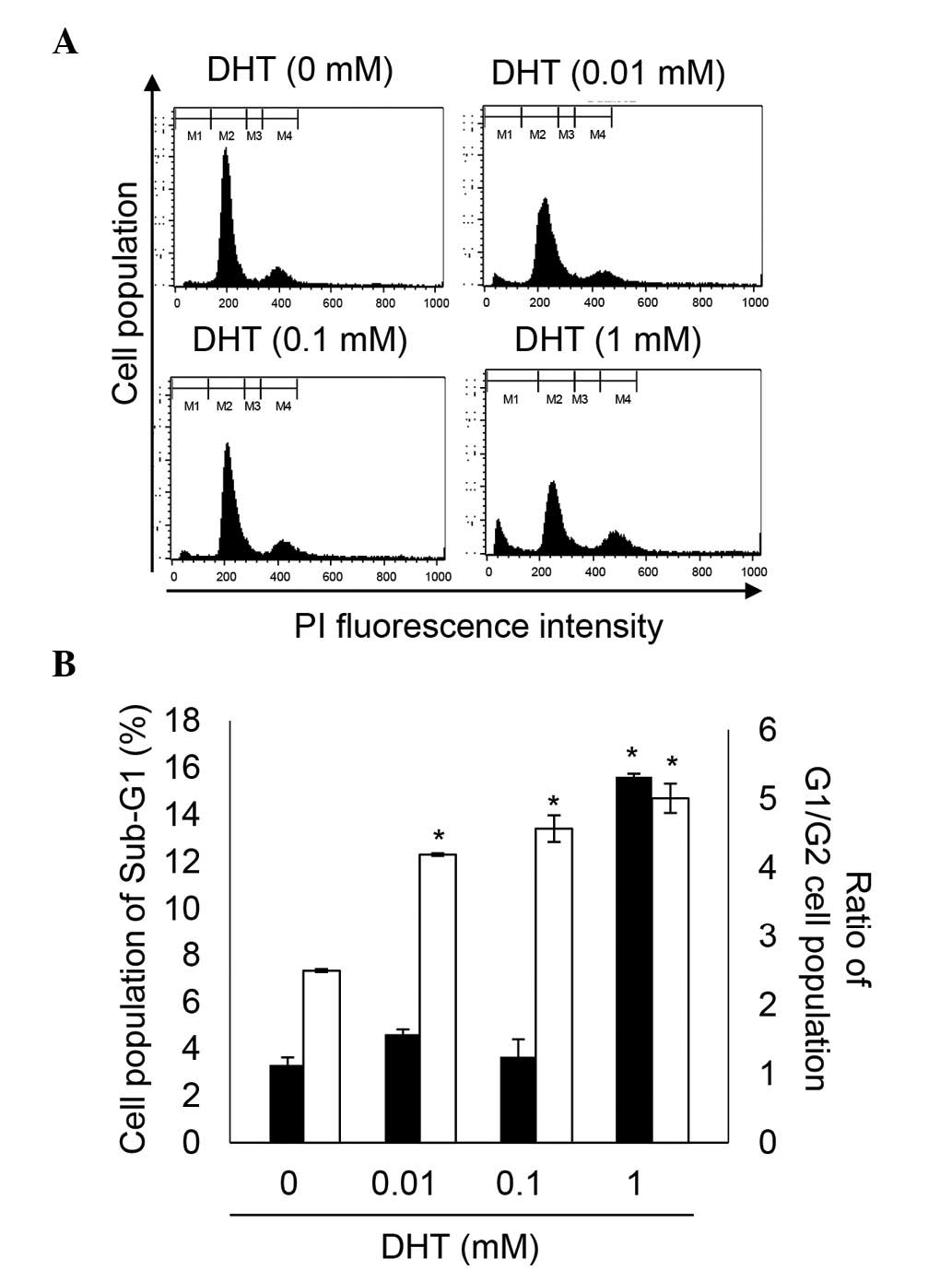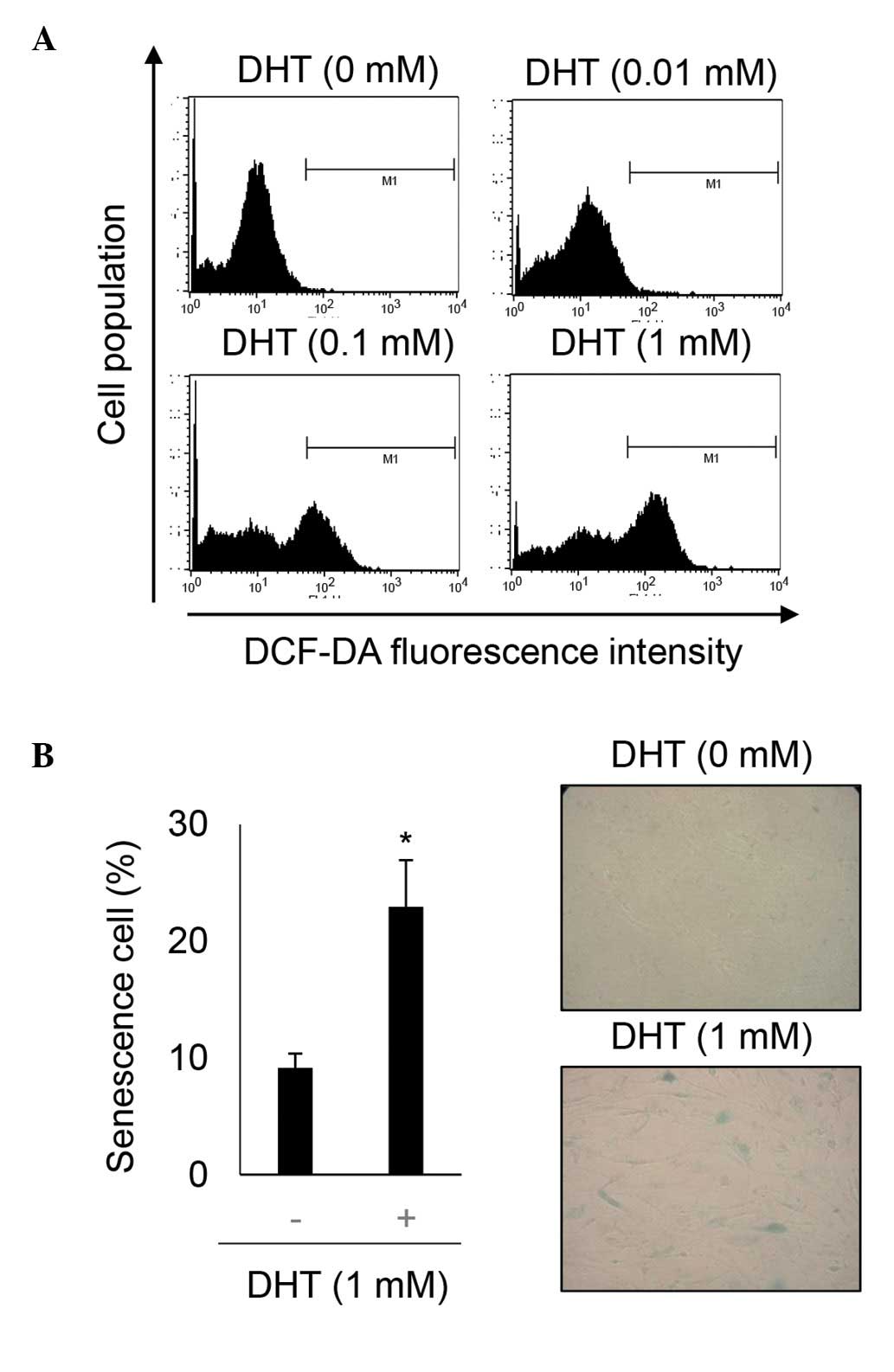|
1
|
Yazdan P: Update on the genetics of
androgenetic alopecia, female pattern hair loss, and alopecia
areata: Implications for molecular diagnostic testing. Semin Cutan
Med Surg. 31:258–266. 2012. View Article : Google Scholar : PubMed/NCBI
|
|
2
|
Alsantali A and Shapiro J: Androgens and
hair loss. Curr Opin Endocrinol Diabetes Obes. 16:246–253. 2009.
View Article : Google Scholar : PubMed/NCBI
|
|
3
|
Canguven O and Burnett AL: The effect of 5
alpha-reductase inhibitors on erectile function. J Androl.
29:514–523. 2008. View Article : Google Scholar : PubMed/NCBI
|
|
4
|
Rove KO, Debruyne FM, Djavan B, Gomella
LG, Koul HK, Lucia MS, Petrylak DP, Shore ND, Stone NN and Crawford
ED: Role of testosterone in managing advanced prostate cancer.
Urology. 80:754–762. 2012. View Article : Google Scholar : PubMed/NCBI
|
|
5
|
Hillier SG and Tetsuka M: Role of
androgens in follicle maturation and atresia. Baillieres Clin
Obstet Gynaecol. 11:249–260. 1997. View Article : Google Scholar : PubMed/NCBI
|
|
6
|
McElwee KJ, Kissling S, Wenzel E, Huth A
and Hoffmann R: Cultured peribulbar dermal sheath cells can induce
hair follicle development and contribute to the dermal sheath and
dermal papilla. J Invest Dermatol. 121:1267–1275. 2003. View Article : Google Scholar : PubMed/NCBI
|
|
7
|
Yang CC and Cotsarelis G: Review of hair
follicle dermal cells. J Dermatol Sci. 57:2–11. 2010. View Article : Google Scholar :
|
|
8
|
Tang L, Bernardo O, Bolduc C, Lui H,
Madani S and Shapiro J: The expression of insulin-like growth
factor 1 in follicular dermal papillae correlates with therapeutic
efficacy of finasteride in androgenetic alopecia. J Am Acad
Dermatol. 49:229–233. 2003. View Article : Google Scholar : PubMed/NCBI
|
|
9
|
Stenn KS, Combates NJ, Eilertsen KJ,
Gordon JS, Pardinas JR, Parimoo S and Prouty SM: Hair follicle
growth controls. Dermatol Clin. 14:543–558. 1996. View Article : Google Scholar : PubMed/NCBI
|
|
10
|
Peus D and Pittelkow MR: Growth factors in
hair organ development and the hair growth cycle. Dermatol Clin.
14:559–572. 1996. View Article : Google Scholar : PubMed/NCBI
|
|
11
|
Stenn KS and Paus R: Controls of hair
follicle cycling. Physiol Rev. 81:449–494. 2001.PubMed/NCBI
|
|
12
|
Ferraris C, Cooklis M, Polakowska RR and
Haake AR: Induction of apoptosis through the PKC pathway in
cultured dermal papilla fibroblasts. Exp Cell Res. 234:37–46. 1997.
View Article : Google Scholar : PubMed/NCBI
|
|
13
|
Kwack MH, Sung YK, Chung EJ, Im SU, Ahn
JS, Kim MK and Kim JC: Dihydrotestosterone-inducible dickkopf 1
from balding dermal papilla cells causes apoptosis in follicular
keratinocytes. J Invest Dermatol. 128:262–269. 2008.
|
|
14
|
Winiarska A, Mandt N, Kamp H, Hossini A,
Seltmann H, Zouboulis CC and Blume-Peytavi U: Effect of
5alpha-dihydrotestosterone and testosterone on apoptosis in human
dermal papilla cells. Skin Pharmacol Physiol. 19:311–321. 2006.
View Article : Google Scholar : PubMed/NCBI
|
|
15
|
Ambros V, Bartel B, Bartel DP, Burge CB,
Carrington JC, Chen X, Dreyfuss G, Eddy SR, Griffiths-Jones S,
Marshall M, et al: A uniform system for microRNA annotation. RNA.
9:277–279. 2003. View Article : Google Scholar : PubMed/NCBI
|
|
16
|
Valencia-Sanchez MA, Liu J, Hannon GJ and
Parker R: Control of translation and mRNA degradation by miRNAs and
siRNAs. Genes Dev. 20:515–524. 2006. View Article : Google Scholar : PubMed/NCBI
|
|
17
|
Ha TY: MicroRNAs in Human Diseases: From
Cancer to Cardiovascular Disease. Immune Netw. 11:135–154. 2011.
View Article : Google Scholar : PubMed/NCBI
|
|
18
|
Andl T, Murchison EP, Liu F, Zhang Y,
Yunta-Gonzalez M, Tobias JW, Andl CD, Seykora JT, Hannon GJ and
Millar SE: The miRNA-processing enzyme dicer is essential for the
morphogenesis and maintenance of hair follicles. Curr Biol.
16:1041–1049. 2006. View Article : Google Scholar : PubMed/NCBI
|
|
19
|
Bae S, Lee EJ, Lee JH, Park IC, Lee SJ,
Hahn HJ, Ahn KJ, An S, An IS and Cha HJ: Oridonin protects HaCaT
keratinocytes against hydrogen peroxide-induced oxidative stress by
altering microRNA expression. Int J Mol Med. 33:185–193. 2014.
|
|
20
|
Kim YJ, Cha HJ, Nam KH, Yoon Y, Lee H and
An S: Centella asiatica extracts modulate hydrogen peroxide-induced
senescence in human dermal fibroblasts. Exp Dermatol. 20:998–1003.
2011. View Article : Google Scholar : PubMed/NCBI
|
|
21
|
Simões VL, Alves MG, Martins AD, Dias TR,
Rato L, Socorro S and Oliveira PF: Regulation of apoptotic
signaling pathways by 5α-dihydrotestosterone and 17β-estradiol in
immature rat Sertoli cells. J Steroid Biochem Mol Biol. 135:15–23.
2013. View Article : Google Scholar
|
|
22
|
Mirochnik Y, Veliceasa D, Williams L,
Maxwell K, Yemelyanov A, Budunova I and Volpert OV: Androgen
receptor drives cellular senescence. PLoS One. 7:e310522012.
View Article : Google Scholar : PubMed/NCBI
|
|
23
|
Mehraein-Ghomi F, Lee E, Church DR,
Thompson TA, Basu HS and Wilding G: JunD mediates androgen induced
oxidative stress in androgen-dependent LNCaP human prostate cancer
cells. Prostate. 68:924–934. 2008. View Article : Google Scholar : PubMed/NCBI
|
|
24
|
Ruizeveld de Winter JA, Trapman J, Vermey
M, Mulder E, Zegers ND and van der Kwast TH: Androgen receptor
expression in human tissues: An immunohistochemical study. J
Histochem Cytochem. 39:927–936. 1991. View Article : Google Scholar : PubMed/NCBI
|
|
25
|
Takahashi A, Ohtani N, Yamakoshi K, Iida
S, Tahara H, Nakayama K, Nakayama KI, Ide T, Saya H and Hara E:
Mitogenic signalling and the p16INK4a-Rb pathway cooperate to
enforce irreversible cellular senescence. Nat Cell Biol.
8:1291–1297. 2006. View
Article : Google Scholar : PubMed/NCBI
|
|
26
|
Hodgins MB, Choudhry R, Parker G, Oliver
RF, Jahoda CA, Withers AP, Brinkmann AO, van der Kwast TH, Boersma
WJ, Lammers KM, et al: Androgen receptors in dermal papilla cells
of scalp hair follicles in male pattern baldness. Ann NY Acad Sci.
642:448–451. 1991. View Article : Google Scholar : PubMed/NCBI
|
|
27
|
Eicheler W, Happle R and Hoffmann R: 5
alpha-reductase activity in the human hair follicle concentrates in
the dermal papilla. Arch Dermatol Res. 290:126–132. 1998.
View Article : Google Scholar : PubMed/NCBI
|
|
28
|
Trüeb RM: Molecular mechanisms of
androgenetic alopecia. Exp Gerontol. 37:981–990. 2002. View Article : Google Scholar : PubMed/NCBI
|
|
29
|
Inui S and Itami S: Molecular basis of
androgenetic alopecia: From androgen to paracrine mediators through
dermal papilla. J Dermatol Sci. 61:1–6. 2011. View Article : Google Scholar
|
|
30
|
Mirochnik Y, Veliceasa D, Williams L,
Maxwell K, Yemelyanov A, Budunova I and Volpert OV: Androgen
receptor drives cellular senescence. PLoS One. 7:e310522012.
View Article : Google Scholar : PubMed/NCBI
|
|
31
|
Colavitti R and Finkel T: Reactive oxygen
species as mediators of cellular senescence. IUBMB Life.
57:277–281. 2005. View Article : Google Scholar : PubMed/NCBI
|
|
32
|
Ninio-Many L, Grossman H, Shomron N,
Chuderland D and Shalgi R: microRNA-125a-3p reduces cell
proliferation and migration by targeting Fyn. J Cell Sci.
126:2867–2876. 2013. View Article : Google Scholar : PubMed/NCBI
|
|
33
|
Anaya-Ruiz M, Bandala C and Perez-Santos
JL: miR-485 acts as a tumor suppressor by inhibiting cell growth
and migration in breast carcinoma T47D cells. Asian Pac J Cancer
Prev. 14:3757–3760. 2013. View Article : Google Scholar : PubMed/NCBI
|
|
34
|
Wang Y, Liu J, Liu C, Naji A and Stoffers
DA: MicroRNA-7 regulates the mTOR pathway and proliferation in
adult pancreatic β-cells. Diabetes. 62:887–895. 2013. View Article : Google Scholar :
|
|
35
|
Fang Y, Xue JL, Shen Q, Chen J and Tian L:
MicroRNA-7 inhibits tumor growth and metastasis by targeting the
phosphoinositide 3-kinase/Akt pathway in hepatocellular carcinoma.
Hepatology. 55:1852–1862. 2012. View Article : Google Scholar : PubMed/NCBI
|
|
36
|
Xiong S, Zheng Y, Jiang P, Liu R, Liu X
and Chu Y: MicroRNA-7 inhibits the growth of human non-small cell
lung cancer A549 cells through targeting BCL-2. Int J Biol Sci.
7:805–814. 2011. View Article : Google Scholar : PubMed/NCBI
|
|
37
|
Chou YT, Lin HH, Lien YC, Wang YH, Hong
CF, Kao YR, Lin SC, Chang YC, Lin SY, Chen SJ, et al: EGFR promotes
lung tumorigenesis by activating miR-7 through a Ras/ERK/Myc
pathway that targets the Ets2 transcriptional repressor ERF. Cancer
Res. 70:8822–8831. 2010. View Article : Google Scholar : PubMed/NCBI
|
|
38
|
Jiang L, Liu X, Chen Z, Jin Y, Heidbreder
CE, Kolokythas A, Wang A, Dai Y and Zhou X: MicroRNA-7 targets
IGF1R (insulin-like growth factor 1 receptor) in tongue squamous
cell carcinoma cells. Biochem J. 432:199–205. 2010. View Article : Google Scholar : PubMed/NCBI
|
|
39
|
Liu S, Zhang P, Chen Z, Liu M, Li X and
Tang H: MicroRNA-7 downregulates XIAP expression to suppress cell
growth and promote apoptosis in cervical cancer cells. FEBS Lett.
587:2247–2253. 2013. View Article : Google Scholar : PubMed/NCBI
|

















